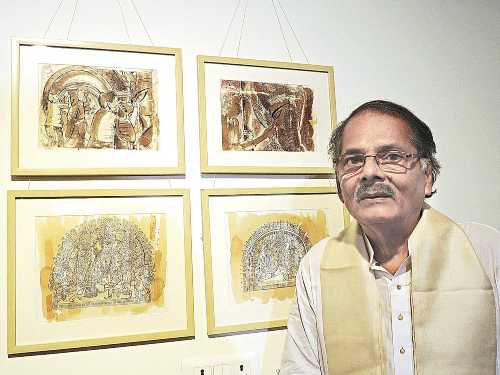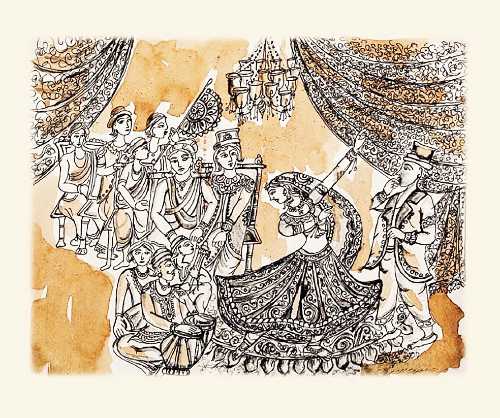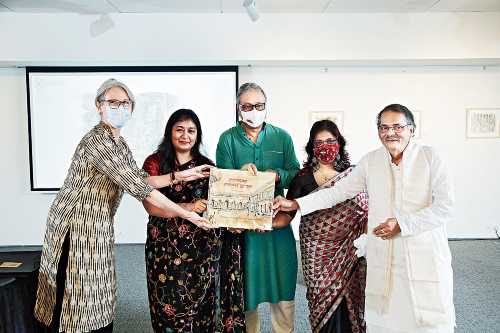The history of north Kolkata’s oldest Durga puja has been told through a collection of 50 sketches and associated captions. The person who has completed the task is himself a member of the Sovabazar Rajbari, where the goddess was first invoked in 1757, to celebrate the victory of the East India Company in the Battle of Plassey. And that pictorial journey across 263 years is currently on view at Kolkata Centre for Creativity.
Prabir Krishna Deb, a seventh-generation descendant of Raja Nabakrishna Deb, is a graduate of Indian Art College, who had initially dabbled in photography and fashion designing. “I returned to painting around 2010. By then, I figured trends had changed from the realistic style, in which we were trained, to abstract. An artist friend, Abhijit Dutta, inspired me to not bother about trends and choose subjects in north Calcutta and my own house to focus on in the style I was comfortable in,” says Deb.
The first result of this advice was a solo exhibition titled ‘Rajbari theke Rajpoth’ (Palace to pavement), at Chemould Art Gallery in 2013. “I drew the arches and the courtyard of our mansion on one hand and sketched the slums and the streets as seen from our roof or windows on the other.”

Artist Prabir Krishna Deb, a seventh-generation descendant of Raja Nabakrishna Deb, at the exhibition. Sudeshna Banerjee
Tales of family traditions
Work on the collection currently on view began in 2020. It starts with portraits of Raja Nabakrishna Deb, the family’s founding father, going for a bath in the Ganges, his bare upper body sheltered by a minion’s umbrella. “It is based on the only existing portrait of his. But I have also drawn an imaginative one of him in full regalia, just as there is one of his son Rajkrishna,” Deb explains.

The nautch girls who performed during Durga puja could sketch with their toes on the dance floor smeared with abir or strewn with petals while dancing

Gunshots being fired before Sandhi puja
The captions of the sketches of the nautch girls inspire awe through its lores. “The dancers were adept in creating outlines of paintings on the dance floor with their toes while dancing, on beds of abir or petals. A guest from the East India Company challenged one to draw a ship. Since she had never seen one, a painting of a ship was brought from the Company’s fort. She took one look at it and accomplished the feat,” he says.
The sketches also document changes in certain family customs. “There used to be a nahabatkhana at the start of what is now called Raja Nabakrishna Deb Street. A cannon used to be fired at the start and end of Sandhi puja as a signal to other pujas to start their respective rituals after ours. The Hooghly used to flow much closer in those days and the cannon shot used to land in the river. Now there is a double-barrelled gun that is fired in the air,” says Deb.
More poignant are the stories of the cessation of Nilkantha release and goat sacrifice.
At the start of the new millennium, the court banned the custom in several household pujas of releasing an Indian Blue Jay on the morning of Dashami to take advance news to Lord Shiva of Durga setting off for Mount Kailash. “The first year, there was resistance from old-timers in the family. But we voluntarily complied from the second year. The arrival of the blue jay in a cage on Navami was a cause of much excitement to us when we were children. We used to feed it caterpillars. But after it was released from the cage the next day, crows invariably attacked and killed it. We used to weep at the sight.”
The first few years after the ban, a clay replica was ritualistically brought to life and released by the priest. “About six years ago, a cousin, Swapan Krishna, suggested that we release a sky lantern instead.” Since then, a fanush with a blue jay painted on it is released. Deb does the painting on the lantern himself.
The custom of animal sacrifice on Saptami, Ashtami and Navami continued till as recently as 2019. It is said Lord Clive had himself made offerings of animals at the inaugural edition in 1757 as thanksgiving for the victory in the Battle of Plassey. “At the pre-Puja meeting in 2020, our 90-year-old aunt, Krishna Basu, made an impassioned appeal in writing to stop the brutal custom. Before her, another ancestor Anath Krishna had tried the same in 1908 — he had even written a book on the subject, titled Jeeb Boli, arguing that the scriptures never mandated blood letting in the name of sacrifice — but failed.” This time, too, the hardliners refused.

But on Saptami, the man entrusted with the sacrifice for years suddenly died. His replacement failed to sever the goat’s neck at one go. “It took him as many as five blows. This was considered so inauspicious that there was fear of ill befalling the family. Thankfully, nothing happened. This emboldened the family to finally put an end to the chhagboli,” he says.
The 69-year-old is happy with the response he is getting to the exhibition. “I plan to work next on the modes of transport down the years at our palace as well as the life of Raja Radhankanta Deb (a scholar and the son of Nabakrishna’s adopted elder son Gopimohun),” he says.
All about the exhibition

(From left) Australian consul general Rowan Ainsworth, Kolkata Centre for Creativity chairperson Richa Agarwal, Rajya Sabha MP Jawhar Sircar, Sushmita Basu Singh of RRitobak and Prabir Krishna Deb release Deb’s book of illustrations at the opening of the exhibition on ‘Durga Puja at Sovabazar Rajbari: A Tryst with History and Heritage’
The exhibition, held by KCC in collaboration with Rritobak, started with an invocation of the goddess through Chandi path by Ranendra Krishna Deb of the Sovabazar family on Saturday. Rajya Sabha MP Jawhar Sircar and Australian consul general Rowan Ainsworth inaugurated the exhibition. They also launched a compilation of the sketches titled The Legacy of Durga Puja at Sovabazar Rajbari, with captions in English and Bengali. “The Sovabazar Rajbari puja was the first major puja of Calcutta. The earlier ones in Bengal were in rural areas. This also marks the beginning of community participation before sarbojanin pujas started in 1910. The Deb family puja was always open to the entire city. This was the first time a puja was converted to a social event,” Sircar said.
He pointed to the lion, the Devi’s mount, in one of the sketches of the idol by Prabir Krishna Deb being shown as a slide show on the screen. “Calcutta had not seen a live lion when the Deb family started their puja. The first lion came to the city in 1883, after the Alipore zoo opened. So the potters saw one only in 1884, after which their lions attained a more realistic look. Before that, what they created was half way between a horse and whatever you call it!”
The exhibition will be on till October 5, 11am to 6pm.
